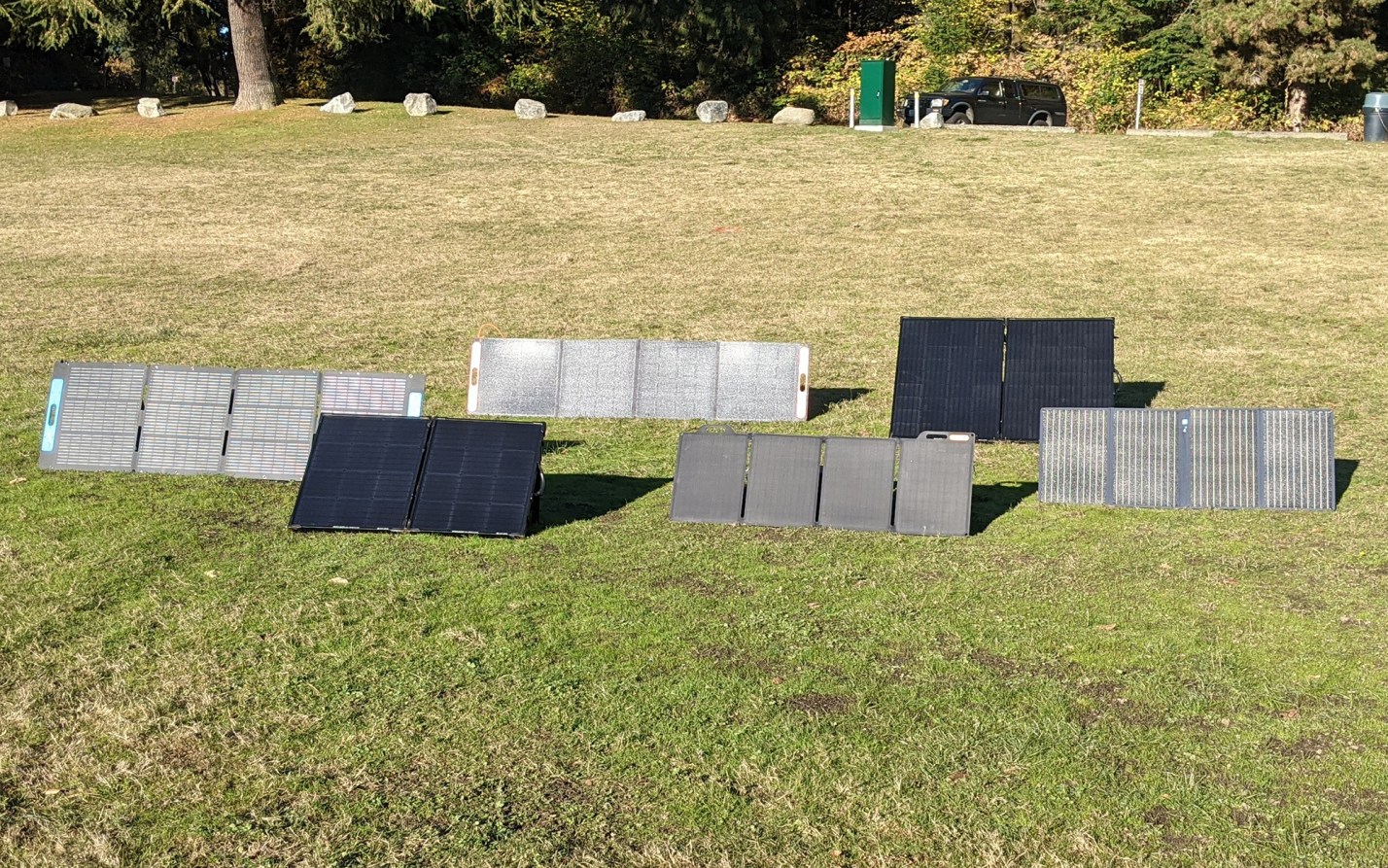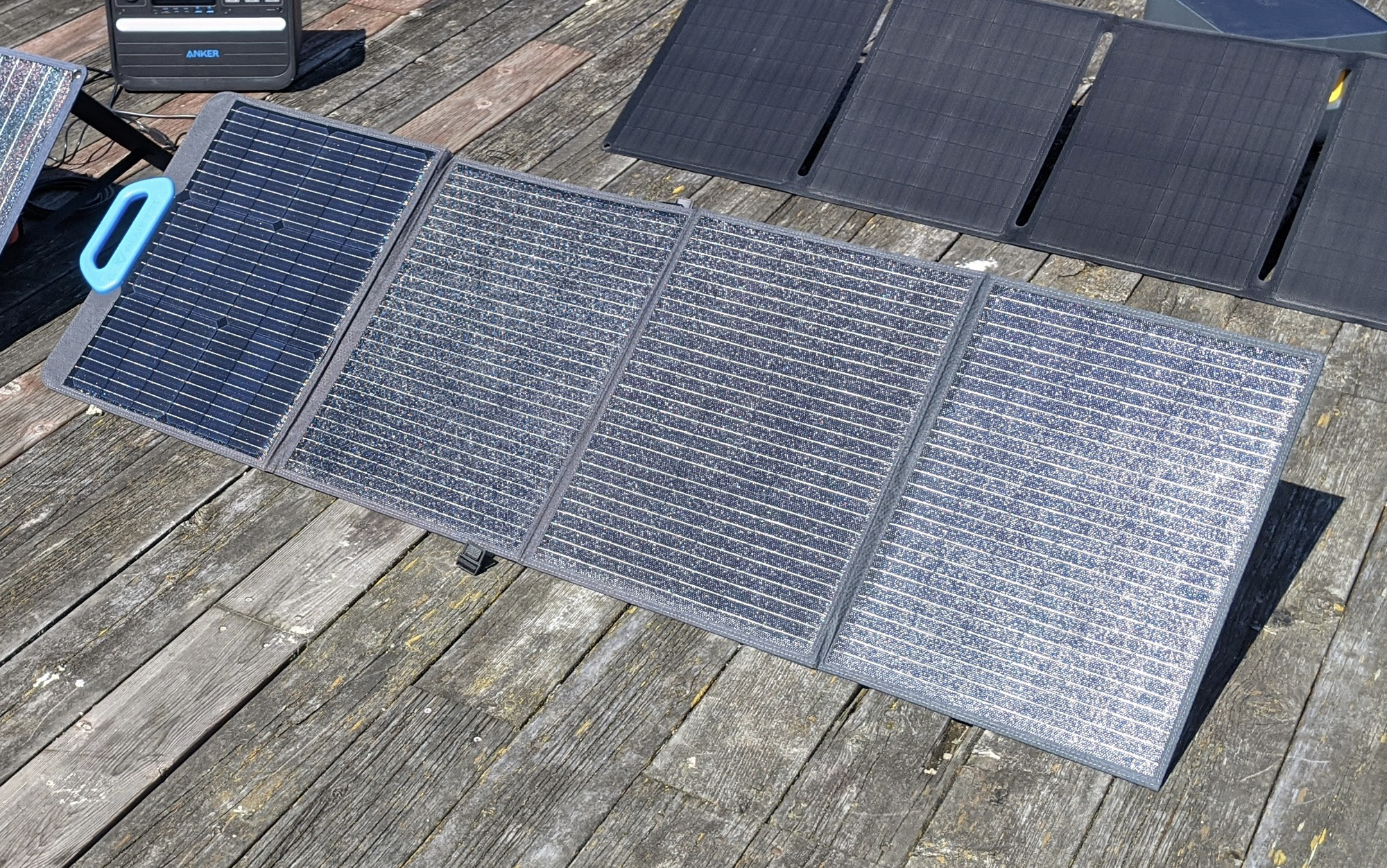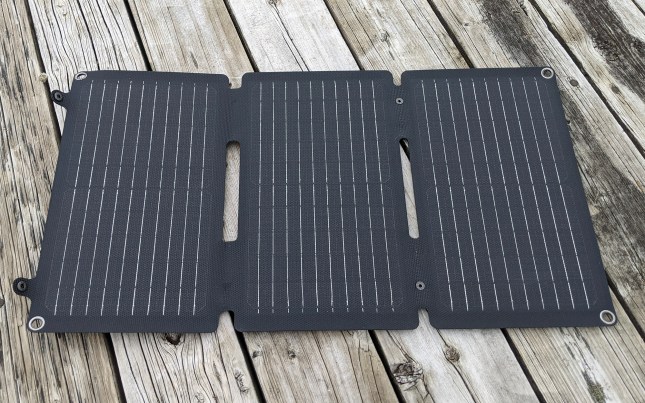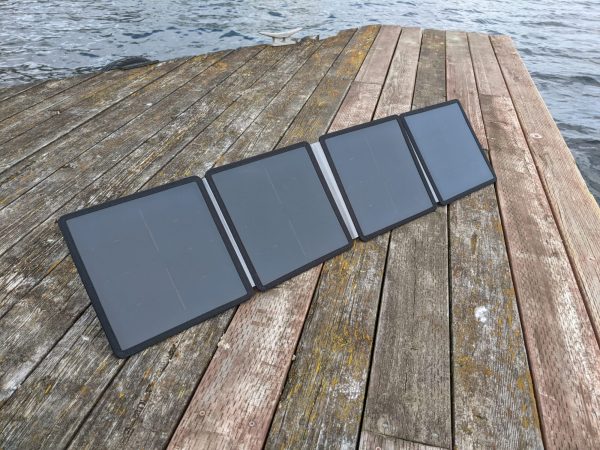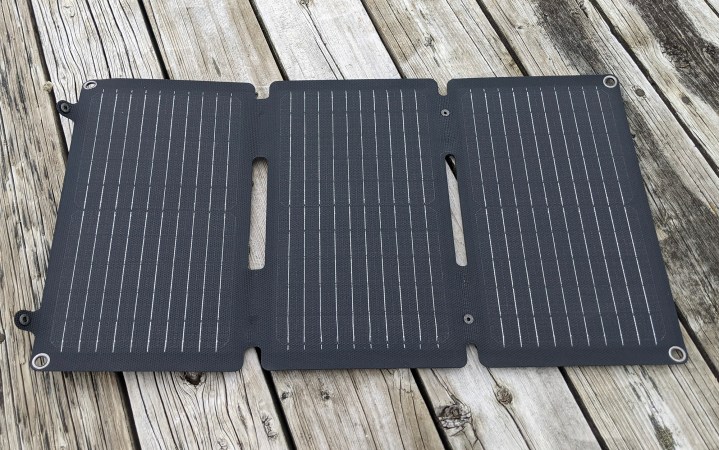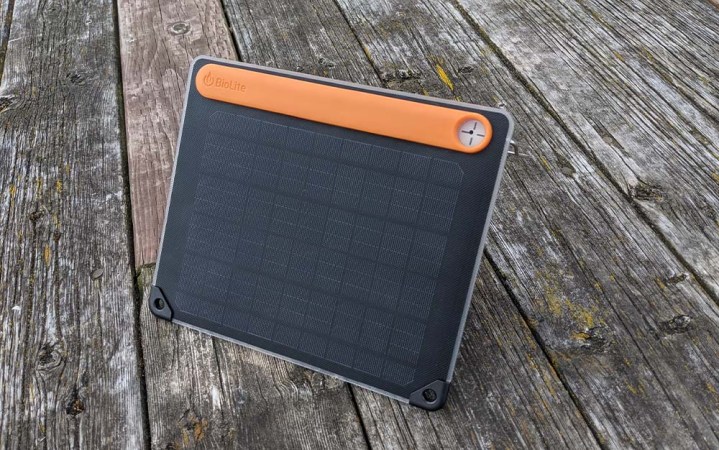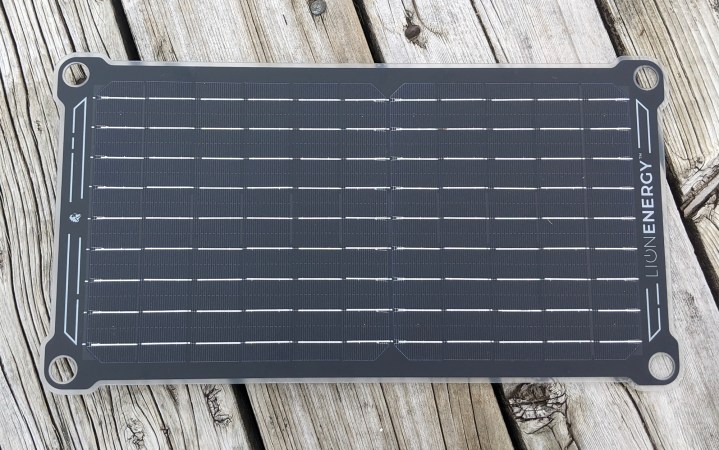We may earn revenue from the products available on this page and participate in affiliate programs. Learn More ›
Experienced campers know that you can get off the grid without having to ditch your electronics if you bring along a great solar panel that’s built for camping and outdoor environments. Modern panels have come a long way since the low amperage models of even a few years ago and with the right setup, you can power anything from a laptop to an electric cooler, with nothing more than a clear view of the sky on a sunny day (sometimes you don’t even need that). To find the best solar panels for camping, I put high-performing models from the top brands to the test:
- Best 200W: Jackery SolarSaga 200
- Best 100W: Bluetti PV120 Solar Panel
- Best 50W: Lion Energy 50W
- Best Solar Charger: BigBlue SolarPowa 30
- Best Solar Power Bank: BioLite SolarPanel 5+
- Best Budget: Lion Energy 10W
How I Tested the Best Solar Panels for Camping
I’ve been testing portable solar panels and solar chargers for years, pitting dozens of models side-by-side in a variety of conditions. I’ve conducted multiple rounds of testing of the best portable solar panels as part of my larger roundup of the best solar generators. More recently, I conducted a deep dive into the best solar chargers which covered 13 different models from 9 different companies. My picks for this story are based on those extensive tests.
When considering which of the units from the above tests were the best solar panels for camping, I considered a number of criteria:
- Packed Size: Most campers have limited car space with which to dedicate to a solar panel set-up, so I prioritized units that I thought delivered maximum oomph for their packed size.
- Power Needs: Dedicated overlanders with electric coolers and beefy power stations need a different panel than campers looking to keep their family’s phones charged.
- Ease of Use: I considered how easy it was to set up and position each solar panel and how easy it was to break them down again for storage.
- Compatibility: I prioritized products that paired easily with power stations and small electronic devices, but still recommend that you check that the provided ports match your needs.
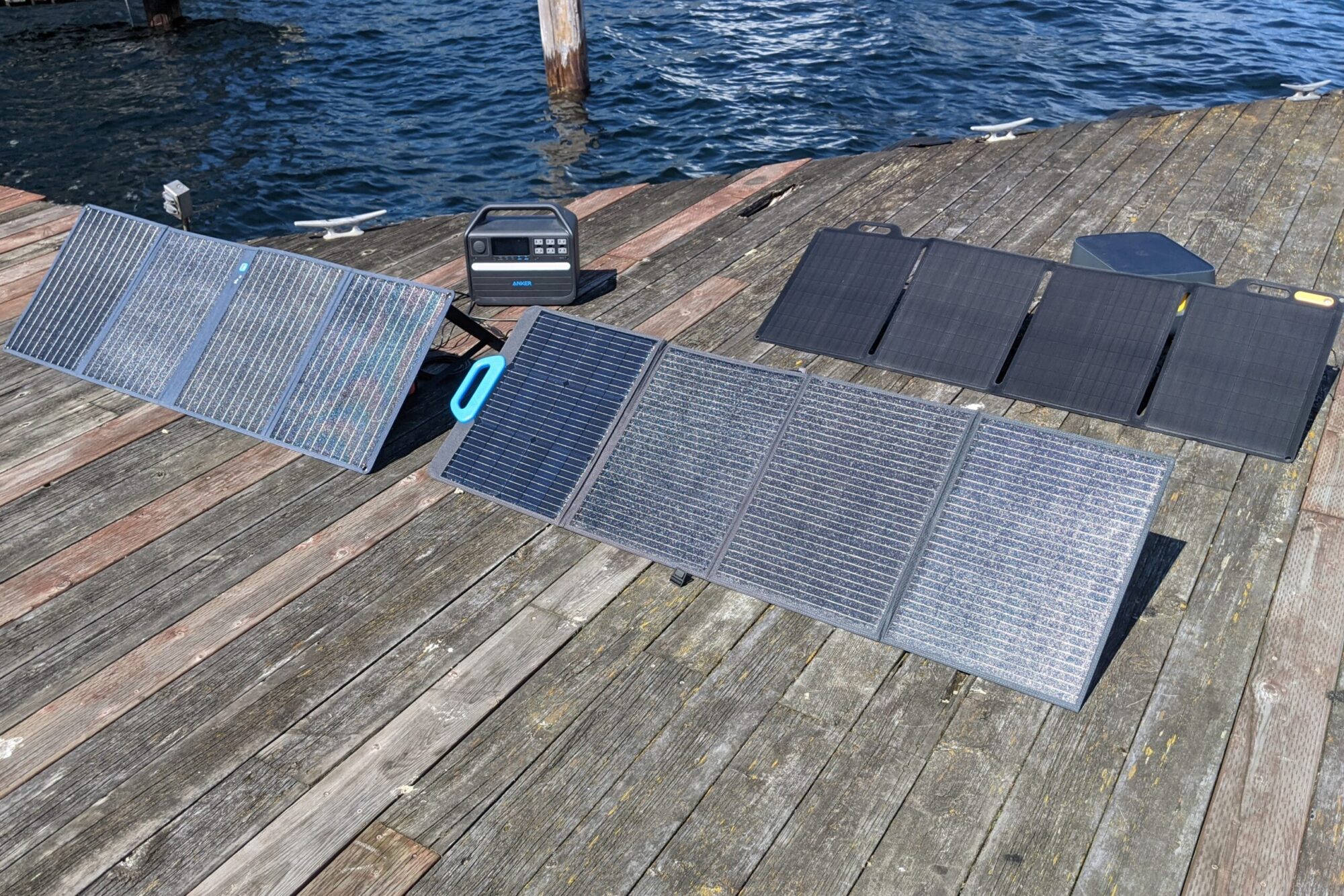
To learn more about each category and see testing results, check out these stories:
The Best Solar Panels for Camping: Reviews and Recommendations
Best 200W: SolarSaga 200W Solar Panel
Key Features
- DC port: 200W (18V)
- Weight: 18 pounds
- Ports: DC only
- Dimensions: 21.2 x 91.3 x 1 inches (unfolded); 21.2 x 24.2 x 1.6 inches (folded)
- Warranty: 3 years
Pros
- Easy to use
- Powerful panel that draws power in every light condition
Cons
- Expensive
- No USB port
The Jackery SolarSaga 200W has consistently impressed me for its ease of use and reliable power generation. When I initially tested this panel, as part of my test of the best solar generators, it registered 184 watts of energy coming from a single panel. At other times it’s exceeded it’s claimed 200 watt output. Even in the shade, it’s impressive, pumping out more power than comparable size panels. I’ve even seen it produce a charge (6 watts) in total shade at dusk.
Each panel comes with a carrying case and a cable that tucks inside of a zipped pocket. The panel accordions up on itself nicely, such that if you could find different storage for the power cord, you could potentially leave the carrying case at home. Something I like about the charging cord for this panel is that it is designed for different voltage requirements on different Jackery power stations. That gives you a lot of flexibility for pairing it with other (potentially non-Jackery) power stations that are already in your arsenal.
Best 100W: Bluetti PV120 Solar Panel
Key Features
- Max output: 120 watts
- Weight: 12.6 pounds
- Ports: MC4 connector (with DC adaptor)
- Dimensions: 65 inches x 21 inches x 1.8 inches (unfolded); 18.5 inches x 21 inches x 3.4 inches (folded)
- Warranty: 12 months
Pros
- Compact package
- Generates over 100 watts of power under clear skies
- Snap features make setup and takedown a breeze
Cons
- No sun dial feature
- Cannot plug directly into a smartphone
The Bluetti PV120 Solar Panel is one of the best solar panels I’ve tested, and just barely squeaked out the Anker SOLIX 100 for the top slot in the 100W category. These two panels, similarly sized and priced (with the Bluetti typically running a bit less expensive), were tested side by side under sunny skies. The Bluetti produced 16 more watts during testing, an over 15 percent difference in performance. I also appreciated that its kickstands had snap buttons at the adjustment points, making it simpler to find the correct angle then on solar panels that lacked that feature.
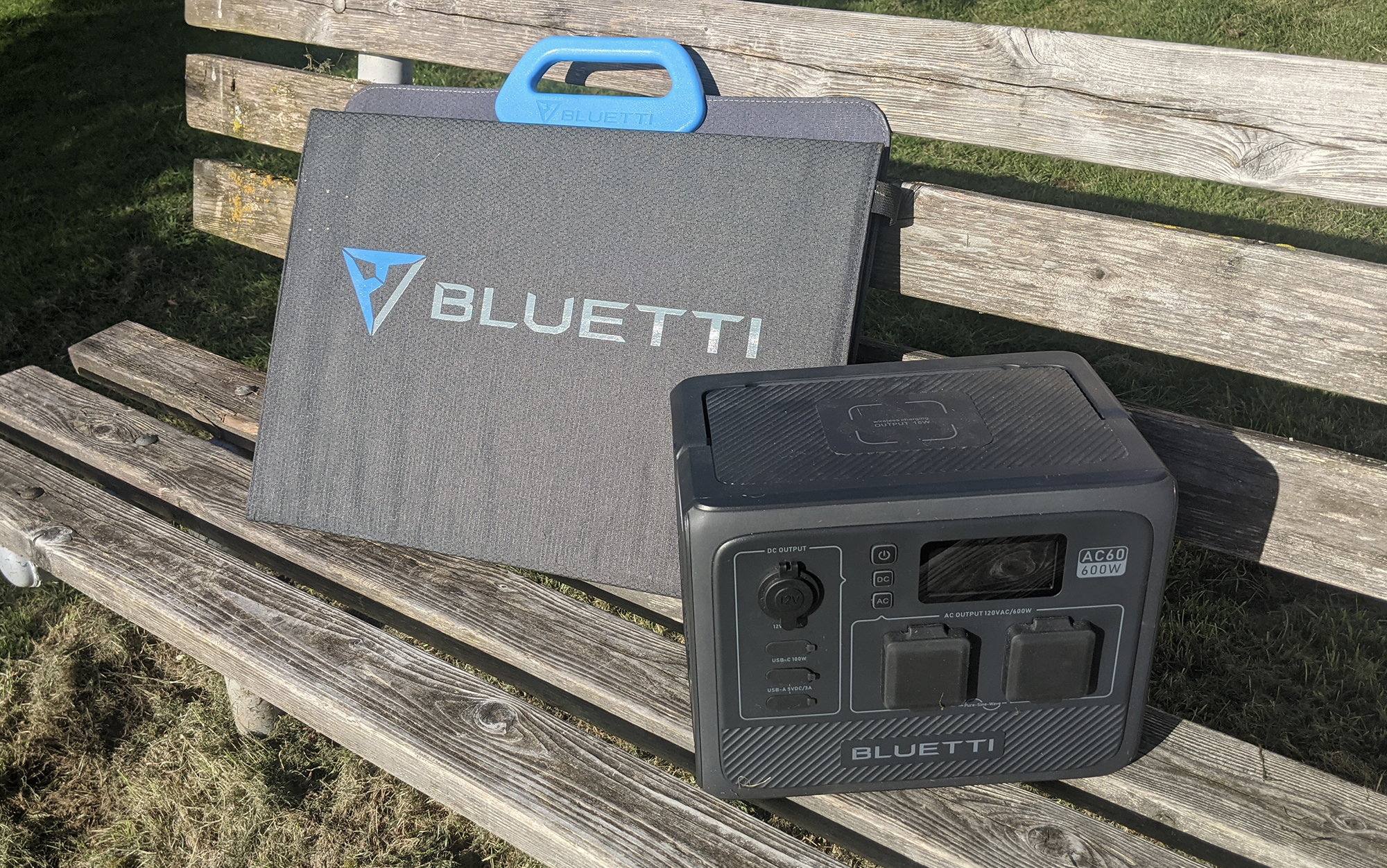
Even storage was simpler, thanks to snaps that wrap around the accordian sides to hold the package together when folded up, eliminating the need for an extra carrying case. This has become my new go-to panel when I head out camping due to its space savings and power generation potential. Even better, since its DC-compatible cable pairs with the Goal Zero Yeti and Jackery power stations, I’m able to use it with my favorite power station for camping.
Best 50W: Lion 50W Foldable
Key Features
- USB max output: 27W (12V)
- DC port: 48W (18V)
- Weight: 3 pounds
- Ports: USB-A, USB-C, and DC
- Dimensions: 46 inches x 11.3 inches x 0.8 inch (unfolded); 11.3 inches x 11.3 inches x 1.6 inches (folded)
- Warranty: 1 year
Pros
- Compact
- More powerful than it looks
- Lightweight
Cons
- Less powerful than larger 100W models
The small packed size of the Lion Energy 50W belies the impressive amount of power it can generate. This was one of the top performers in my test of the best solar chargers. If you’re looking for a unit that you can plug your phone into on even cloudy days and get a full charge, this is it.
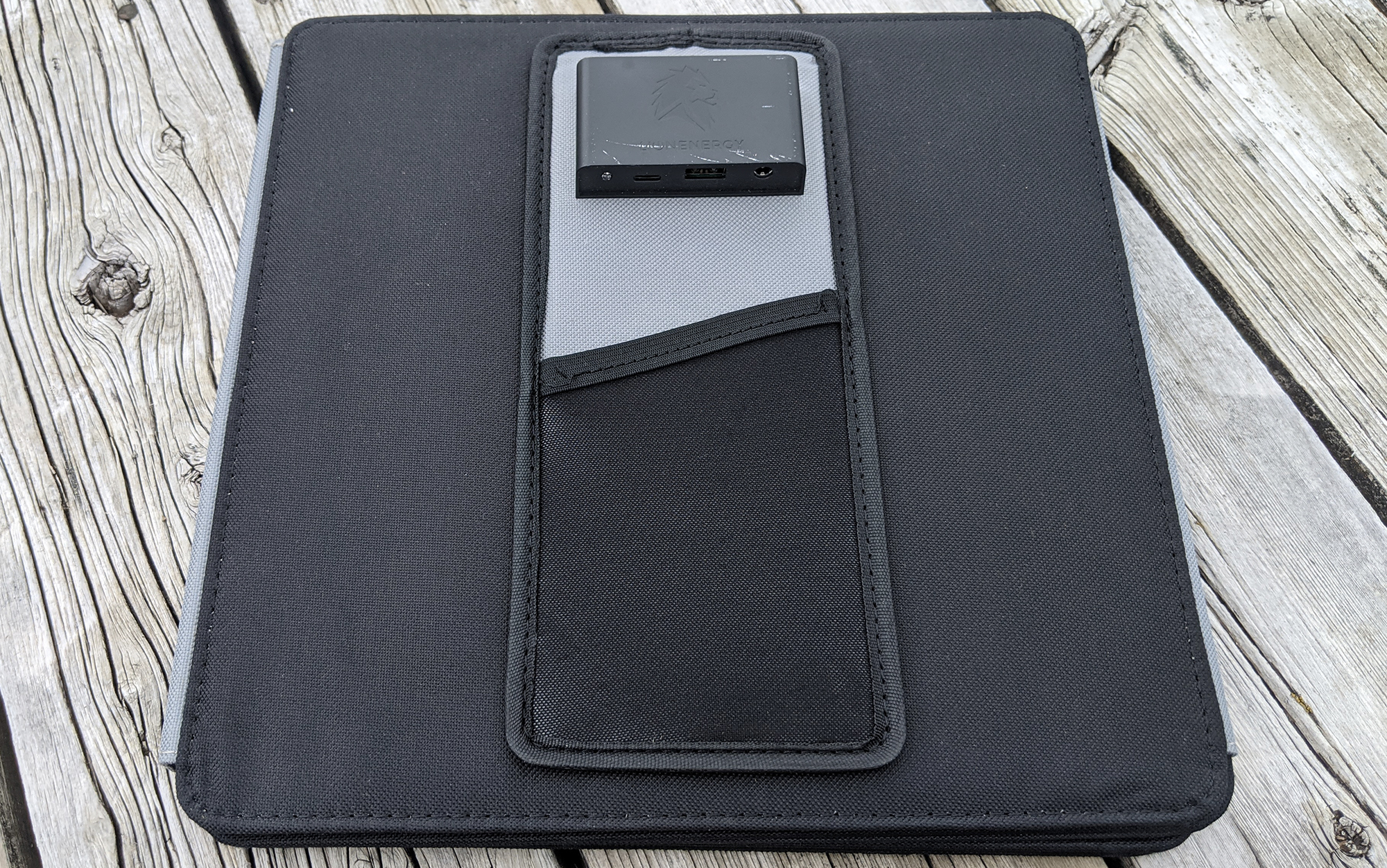
Laura Lancaster
While you have the option to pair this unit with a power bank to take full advantage of the 50W potential (outside of the scope of my solar charger test), you can also plug electronics directly into it using a USB-A or USB-C cable. While this is just too large and too heavy to consider for a backpacking trip, its combination of small size and power make it practically a necessity for a pack rafting or canoe trip. (Just make sure you pair it with one of the best dry bags.)
Best Solar Charger: BigBlue SolarPowa 30
Key Features
- Ports: USB-A, USB-C, and DC
- Kickstand: Yes
- Cord Storage: No
Pros
- Winner of my best of the best solar chargers
- Reasonably priced
- Snap buttons securely close the unit when folded
Cons
- No cord storage
- Not as powerful in cloudy conditions
The BigBlue SolarPowa 30 impressed during testing, generating 17.8 watts of power out of its USB-C port under sunny skies and clocking 5.5 watts in the shade. That means it should reliably charge your phone in most conditions. And it accomplishes that at well under $100.
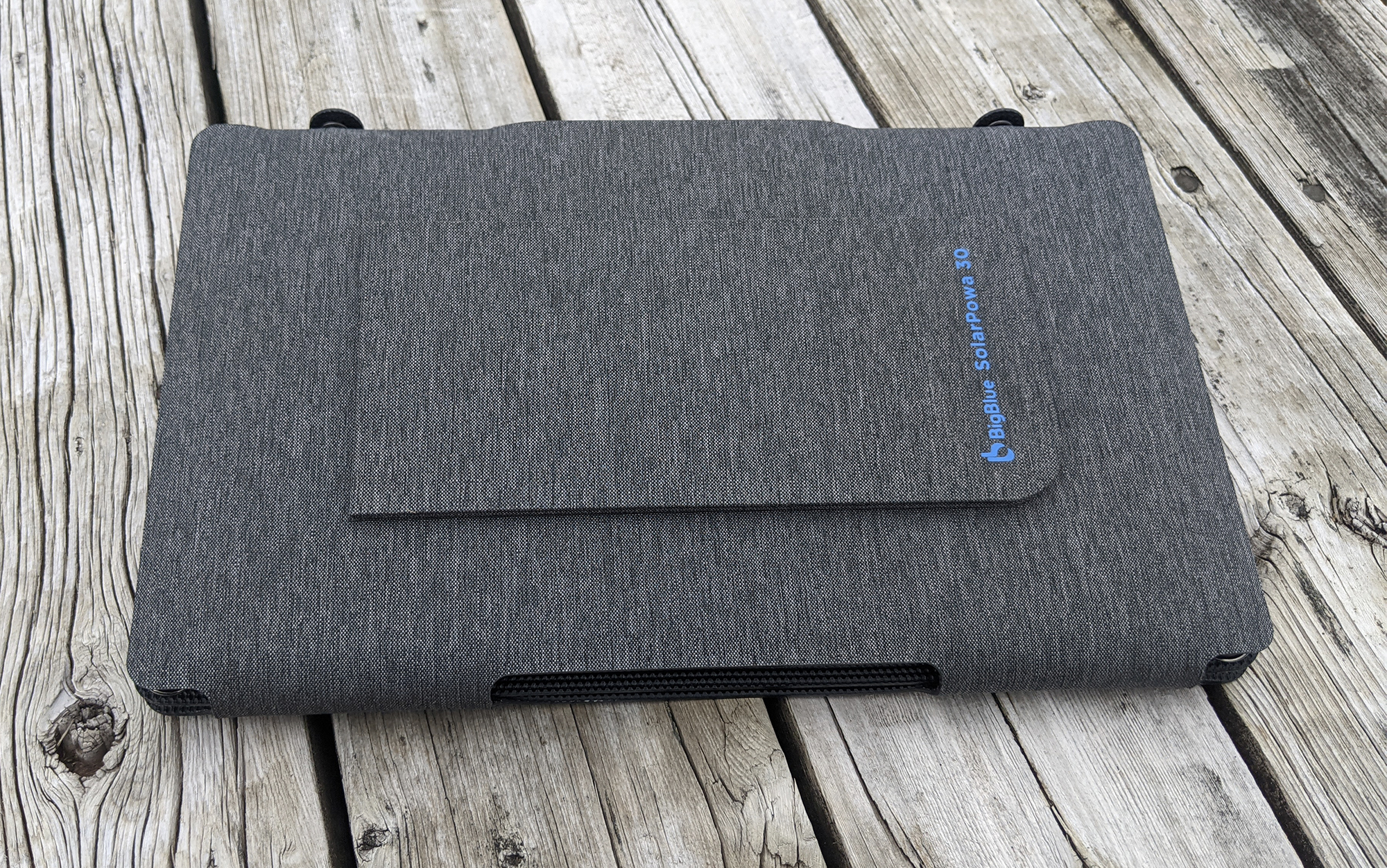
Laura Lancaster
While this panel only has one kickstand, in testing that was enough to aim it at the sun; however, the stiffness of the material connecting the three panel sections together had a tendency to hold its shape after being in storage for some time. Fortunately, it bent back without too much difficulty, and showed no signs of wear in the process. The BigBlue SolarPower 30 was on the larger side in my test, but this panel is still petite compared to the best portable solar panels and should take up virtually no space in your car camping kit. It’s even small enough that I would consider bringing it along on very short backpacking trips.
Best Solar Power Bank: BioLite SolarPanel 5+
Key Features
- Max power output: 5W
- Weight: 13.8 ounces
- Ports: USB-A
- Dimensions: 10.1 inches x 8.2 inches x 1 inch
- Also available in SolarPanel 10+
- Warranty: 1 year
Pros
- 3200mAh internal battery
- Affordable
- Small and lightweight
- Integrated sundial and adjustable kickstand
Cons
- Slowest charging time of the solar panels I tested
- Performs poorly in even slightly cloudy weather
Not everyone is looking to charge an electric cooler or laptop while camping. Sometimes, you just want to juice up your phone a bit, so that you don’t have to monitor how much battery is left over the course of your trip.
The BioLite Solar Panel 5+ is essentially a low-cost alternative to a smaller battery pack. Its max output is only 5 watts, which, while too low to charge a larger battery pack, is ideal for charging a smartphone. I also liked that it featured an adjustable kickstand (the only one of the solar panels I tested) and an integrated sundial, which I used to optimize the positioning of the panel during testing. However, it still took the BioLite Solar 5+ 22 minutes to charge my phone 5 percent, even though it was sunnier (although still quite cloudy) than during other parts of my test. Unlike the other other panels, which could be used to spot charge a device on the go, the best and highest use of the BioLite is to charge the onboard 3,200 mAh battery (which can also be charged before leaving home via a micro USB port), speeding up your smartphone recharge so that you can get going again.
Best Budget: Lion Energy 10W
Test Results
- Tested Watts (Full Sun): 6.4W (USB-A)
- Tested Watts (Shade): 2.9W (USB-A)
- Weight: 10 ounces
- Packed Size: 15 x 7.5 x .5 inches
Key Features
- Ports: USB-A
- Kickstand: None
- Cord Storage: None
Pros
- Very lightweight and space efficient
- Lowest priced option I looked at
- Surprising power generation
Cons
- Doesn’t fold down
- Only has a USB-A port
- Low energy output in the cloudy conditions
Dollar for watt, there was no more efficient solar charger that I looked at than the Lion Energy 10W. It had almost an identical power output to the Goal Zero Nomad 10, but at a quarter of the price. It was also the lightest weight panel I tested, although that came with a catch: There is no way to fold this panel up, and it only sports a single USB-A port. While this panel didn’t have a very high energy output when the clouds rolled in, it’s still likely to be a popular choice for emergency kits and backpackers who want to experiment with swapping out of the best power banks for a solar charger.
Things to Consider Before Buying a Solar Panel for Camping
How Solar Panels Work
At its most basic, solar panels are made up of solar cells that convert sunlight into electricity. Each cell has two conductive layers, in between which are two different types of silicone—one with extra electrons, and one with space for electrons. When sunlight hits a solar panel, it sends a photon slamming into a solar cell, which in turns knocks one of the extra electrons loose. When that electron makes its way over to one of the silicone layers with space for electrons it creates a positive charge on one side and a negative charge on another. The solar cell channels the movement of the electrons, so that it can capture the energy it produces as it moves. While the amount of energy captured by each solar cell is negligible, when strung together in a solar panel, it can be quite impressive, with some of the solar panels in my test able to produce as many as 100W.
Some solar panels are better at regulating this output of energy than others, which matters when you are trying to capture this energy on the other side, whether in a power bank or directly into a device like some of the best solar generators. For instance, if you try to charge your smartphone on a port that can output 20V of power, then there is a good chance that you’ll damage the battery of your phone, even if in the moment it appears that your phone is simply charging extremely quickly. The solar panels in my test limited the voltage output from the USB ports (5V or less), while the DC ports, which are intended to pair with one of the best power banks for camping, provided a higher voltage output (between 14.5V and 26.5V). While this provides some protection against accidentally overcharging your devices, it’s still worth knowing how the max voltage output of each solar panel port compares to what your device’s or power bank’s battery can handle.
Power Output
While there are differences in the power ratings between solar panels, generally speaking, the larger a solar panel is, the more power it will generate. This is why solar panels for camping are typically folded twice or more—to maximize the amount of surface area they can cover when in use, while also minimizing the amount of space they occupy during transit.
Packed Size
While most people have plenty of room to spread out a solar panel unit at camp, the same can not always be said of the vehicle you use to get to get there. If your space is limited, the weather is predictable, and your power needs are low, consider a smaller solar panel.
External Battery
Many of the best solar panels for camping are designed to pair with a power bank for camping. This is because most solar panels do not have a way to store the electricity they generate when the sun is shining for those times when it’s overcast or slightly cloudy. Further, since the USB ports on most solar panels for camping limit the voltage output—to prevent inadvertent damage to the battery of smaller electronics, it’s important to ensure that your solar panel has a port that matches the high voltage output port of your power bank.
FAQs
Solar panels for camping can cost anywhere from $30 to over $500, depending on the size and quality of the panels.
The size solar panel that is best for camping depends on what you are trying to charge with it. If you are looking to charge a smartphone, then a smaller single panel (with an accompanying battery) is all you’ll need to get going. If you have multiple appliances or devices that you are looking to charge, then a triple or quadruple panel setup (or even an array chained together) will work better.
If you try to charge your smartphone on a port that can output 20V of power, then there is a good chance that you’ll damage the battery of your phone, even if in the moment it appears that your phone is simply charging extremely quickly. The solar panels in my test limited the voltage output from the USB ports (5V or less), while the DC ports, which are intended to pair with a battery pack, provided a higher voltage output (between 14.5V and 26.5V). While this provides some protection against accidentally overcharging your devices, it’s still worth knowing how the max voltage output of each solar panel port compares to what your device’s or power bank’s battery can handle.
Final Thoughts
After testing the best solar panels for camping as part of my tests of the best portable solar panels and best solar chargers, here are my top picks for the great outdoors.
- Best 200W: Jackery SolarSaga 200
- Best 100W: Bluetti PV120 Solar Panel
- Best 50W: Lion Energy 50W
- Best Solar Charger: BigBlue SolarPowa 30
- Best Solar Power Bank: BioLite SolarPanel 5+
- Best Budget: Lion Energy 10W
